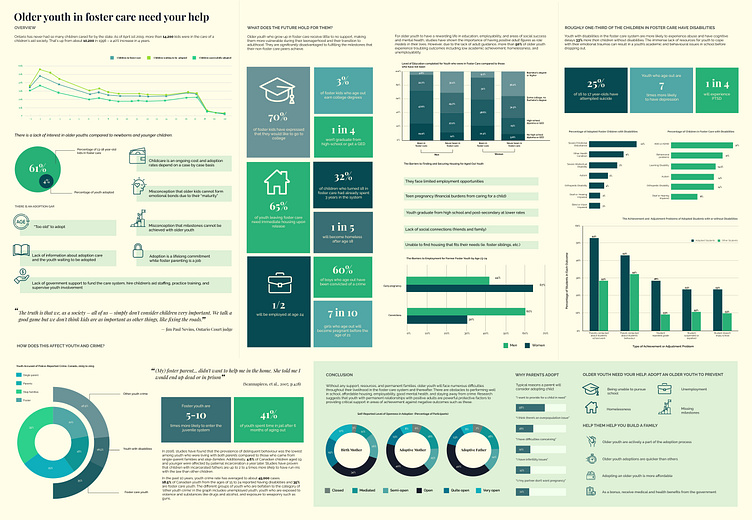Youth Discrimination
Data visualization on Youth Discrimination
Project Type: College Group Project
Visual Design
At the beginning of the process, we focused on building a strong mood board that can be used to draw inspiration from and act as a base for the mega map's visual designs. Youth discrimination, foster care, and adoptions are in-depth topics, so we maintained a serious tone throughout. We focused on our adjectives such as serious, decisive, concerning, urgent, and casual-informative. Our decision in choosing shades of teal and blue throughout our mega map was to upkeep with the serious tone while being casual-informative at the same time. Our primary focus is to encourage parents to adopt older children in foster care and the objective of our graphs was to support the narrative.
In our planning and organization stage, we used wireframes to draw the audience's eye to the mega map's essential segments. Organizing the map backed by narrative was crucial in this process. The top part of the map will introduce the audience to the topic and explain the developmental issues youth face during education and how it affects their employment. The bottom segment of the map explains youth's crime rates and the conclusion of the topic with a Call To Action.
Storytelling
Youth discrimination is a serious topic and we analyzed a gap in the foster care system. The average age in foster care is 7.7 years, and babies get adopted very quickly. There is a significant decrease in adoptions after a child turns 8 and even more reductions after the child enters their teenagehood. Our primary focus audiences are parents looking to adopt and spread awareness that adopting older children will positively impact both the child and the parent's lives. The mega map's narrative shines on what an average child in foster care faces and how adoption can improve the child's quality of life. We focus on the various aspects of the child's life and what they experience in and out of foster care. We shine a light on the child's developmental barriers in terms of education and health, employment, and youth crime. The entire narrative explains the overall life of youth in foster care and how adopting will create a more significant impact on the child, parents, and society. The mega map concludes by encouraging parents to adopt older children by listing the benefits of adopting teens.
